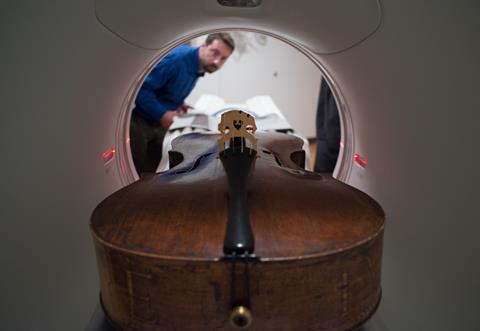
Researchers at the National Music Museum in South Dakota, US, have used hospital scanning equipment to gather information on the construction of what is thought to be the oldest surviving cello, the 'King', made by the 16th-century Cremonese luthier Andrea Amati (c.1505–1577).
Matthew Zeller, a graduate research assistant at the museum and John Koster, a conservator, used CT scanning equipment to examine the 'King', which was made sometime after 1538 and is the oldest known surviving cello in the world made in the form we use today. The research could shed new light on the historical and social contexts surrounding the instrument and maker.
With the assistance of radiology manager Randy Jarvis of the Sanford Vermillion Medical Clinic, Zeller and Koster took a high-resolution scan initially to establish the condition of the instrument and to identify the originality of the materials used for its construction. Following a physical examination the dimensions of the instrument will be calculated taking into consideration established geometric design principles, published research on the painted decorations adorning the instrument and new research on instrument design.
‘Computer assisted tomography has been used for many years in musical instrument research,’ said Zeller. ‘At the National Music Museum we have been periodically CT scanning musical instruments for several years, and we have collected CT scan analyses on many of the musical instruments and bows in our collection. The benefits of CT scanning is that one can see a cross-section of the instrument on any plane without compromising its integrity, and precisely measure the internal structure and dimensions without removing its belly.
‘In addition to taking linear and non-linear measurements, CT scans can provide density readings and make materials like glue, ink and metals identifiable. It is also possible to identify hidden conservation issues, which means you can assess the instrument’s condition and make an educated decision on how to direct your research or conservation.
'Regarding the King cello, so far I have been able to detect variations in the wood grain that may indicate the presence of non-original wood joints. This will aid in the possible identification of alterations and perhaps in the reconstruction of its original dimensions.'
Similar analyses are also being conducted on the museum’s small and large Amati violins, one made c.1560 and the other in 1574, both of which are in excellent condition and have not been reduced in size. Zeller anticipates the project being completed by April 2014:
Amati, the founder of the Cremonese school of violin making, established a consort of new violin family instruments, consisting of five sizes: the small and large violins, small and large violas and a larger version of the instrument now called the cello. Once the dimensions have been established the researchers hope to determine the cello’s geometric relationship with the other Amati instruments, as well as the alterations it has undergone throughout its history.
The National Music Museum at the University of South Dakota, Vermillion, is home to a collection of stringed instruments by the Amatis, Stradivari, Maggini, Gasparo da Salò and Jacob Stainer.
The Amati ‘King’ cello features in The Strad Calendar 2014: Decorated Instruments.
Listen to an excerpt from a performance by Joshua Koestenbaum playing the 'King' at the National Music Museum.
Subscribe to The Strad or download our digital edition as part of a 30-day free trial.








































No comments yet